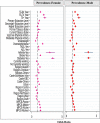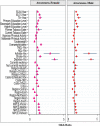Sex-specific prevalence, awareness, treatment and control of hypertension in adults in India: a study for developing sex-specific public policy from the longitudinal ageing study in India (LASI) data 2017-2018
- PMID: 37626344
- PMCID: PMC10464490
- DOI: 10.1186/s41043-023-00404-3
Sex-specific prevalence, awareness, treatment and control of hypertension in adults in India: a study for developing sex-specific public policy from the longitudinal ageing study in India (LASI) data 2017-2018
Abstract
Background and objective: Hypertension is a key risk factor for cardiovascular disease and the leading cause of mortality among Indian adults. The difference in health status between men and women is becoming a great burden in itself worldwide. This study aimed to examine the differences between men and women in the prevalence, awareness, treatment, and control of hypertension and related risk factors among people aged 45 and older in India using data from the Longitudinal Ageing Study in India in 2017-2018.
Methods: Descriptive statistics were presented separately for males and females. Multivariable logistic regression was used to analyze the socio-demographic, lifestyle behaviours, and biological factors associated with the prevalence of hypertension. All statistical analyses were conducted using Stata Version 16.0 statistical software. The study of the data was conducted using survey weights available in the LASI datasets.
Key findings: Overall, the study found that 45.1% of the study population had hypertension, with 26.9% self-reporting their condition and 30% having hypertension at the time of measurement. Approximately 41% of males and 59% of females had hypertension. The self-reported hypertension of men was found to differ significantly from measured hypertension by 8.7%, while in women the difference was only 1.2%. Diabetes was found to increase the odds of having hypertension in both males (OR = 3.65, 95% CI (3.37-3.97)) and females (OR = 3.46, 95% CI (3.21-3.74)).
Conclusion: The difference between self-reported and measured hypertension in men and women is contributing to sex-gender and health inequalities that must be addressed. For adult females with hypertension, it is important to prioritize obesity, education level, physical activity, and regular clinic visits to manage chronic conditions. Based on our findings, policy recommendations can be made to focus on increasing women's literacy, promoting men's screening for hypertension, banning tobacco and alcohol sales, and organizing hypertension awareness campaigns specifically for men and in rural areas.
Keywords: Hypertension; India; Longitudinal Ageing Study in India-2017–2018; Sex.
© 2023. BioMed Central Ltd., part of Springer Nature.
Conflict of interest statement
The authors declare that there is no competing interest. Data has been taken from LASI other than that there has been no contribution and influence of LASI and ICMR in the manuscript and revision of manuscript. Both authors were not supported by the LASI or ICMR in this study.
Figures
Similar articles
-
Hypertension in India: a gender-based study of prevalence and associated risk factors.BMC Public Health. 2024 Oct 1;24(1):2681. doi: 10.1186/s12889-024-20097-5. BMC Public Health. 2024. PMID: 39354462 Free PMC article.
-
Socio-demographic and lifestyle factors associated with intrinsic capacity among older adults: evidence from India.BMC Geriatr. 2022 Nov 12;22(1):851. doi: 10.1186/s12877-022-03558-7. BMC Geriatr. 2022. PMID: 36368936 Free PMC article.
-
Prevalence and associated factors of cardiovascular diseases among men and women aged 45 years and above: Analysis of the longitudinal ageing study in India, 2017-2019.Indian Heart J. 2023 Jan-Feb;75(1):31-35. doi: 10.1016/j.ihj.2022.12.003. Epub 2022 Dec 19. Indian Heart J. 2023. PMID: 36549638 Free PMC article.
-
Prevalence, awareness, and control of hypertension among Asian Indians living in urban Singapore and rural India.J Hypertens. 2013 Aug;31(8):1539-46. doi: 10.1097/HJH.0b013e328361d52b. J Hypertens. 2013. PMID: 23666423 Review.
-
Emerging trends in hypertension epidemiology in India.J Hum Hypertens. 2019 Aug;33(8):575-587. doi: 10.1038/s41371-018-0117-3. Epub 2018 Sep 25. J Hum Hypertens. 2019. PMID: 30254382 Review.
Cited by
-
Interaction between obesity and asthma in children and adolescents with hypertension based on NHANES 2007-2020.Front Public Health. 2025 Apr 28;13:1526832. doi: 10.3389/fpubh.2025.1526832. eCollection 2025. Front Public Health. 2025. PMID: 40356845 Free PMC article.
-
Is gender a factor in socioeconomic disparities in undiagnosed, and untreated hypertension in Bangladesh?J Clin Hypertens (Greenwich). 2024 Aug;26(8):964-976. doi: 10.1111/jch.14858. Epub 2024 Jul 2. J Clin Hypertens (Greenwich). 2024. PMID: 38953454 Free PMC article.
-
Association between rural-to-urban migration and the onset of hypertension among middle-aged and older population: evidence from India.BMC Public Health. 2025 Jul 3;25(1):2355. doi: 10.1186/s12889-025-22267-5. BMC Public Health. 2025. PMID: 40610945 Free PMC article.
References
-
- Prenissl J, Manne-Goehler J, Jaacks LM, Prabhakaran D, Awasthi A, Bischops AC, et al. Hypertension screening, awareness, treatment, and control in India: A nationally representative cross-sectional study among individuals aged 15 to 49 years. PLoS Med. 2019;16(5):e1002801. doi: 10.1371/journal.pmed.1002801. - DOI - PMC - PubMed
-
- WHO. World Health Organization (WHO). Fact Sheet on Noncommunicable Diseases. [Internet]. WHO; 2021. https://www.who.int/news-room/factsheets/
MeSH terms
LinkOut - more resources
Full Text Sources
Medical



